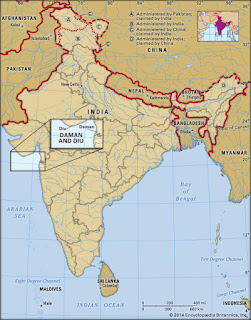For over 450 years, the coastal enclaves of Daman (Portuguese: Damão) and Diu on the Arabian Sea coast were part of Portuguese India, along with Goa and Dadra and Nagar Haveli. Goa, Daman and Diu were incorporated into the Republic of India on December 19, 1961, by military conquest. Portugal did not recognize the Indian annexation of these territories until 1974.
The territory of "Goa, Daman and Diu" was administered as a single union territory until 1987, when Goa was granted statehood, leaving Daman and Diu as a separate union territory. Each enclave constitutes one of the union territory's two districts. Daman and Diu are approximately 650 kilometres away from each other by road.
Beaches
*Nagoa Beach
Nagoa beach is home to a peculiar branching palm called “Hoka”. Brought by the Portuguese, Diu is the only place in India to have a luxuriant growth of these trees.
*Ghoghla Beach
Ghoghla Beach, with its golden sands, is the largest beach on the island of Diu. For those seeking adventure, this beach presents the perfect opportunity for swimming, sunbathing, parasailing or surfing. Food and accommodation are easily available at the beach. Ghoghla beach offers splendid views with occasional sightings of dolphins.
*Chakratirth Beach
This beach is centrally located, adjoining the town of Diu.
*Gomtimata Beach
With its quiet environment, ceaselessly rolling waves and white-sands, the Gomtimata Beach has a mesmerising effect on those who come seeking a moment of repose.
*Jallandhar Beach
Climb the hillock located just off Jallandhar beach to find the stone
carved face of Jallandhar, a mythological demon who was killed by Lord
Krishna.
Monuments
*Diu Fort
Built in 1535, this Portuguese fort was known to provide a strategic vantage point against enemy attacks.
*Fortress of Panikota
Also known as ‘Fortim do Mar’, this magnificent seafort is built at the mouth of the creek and can be accessed only by canoe or motor boat. In it also reside a lighthouse and a chapel consecrated to Our Lady of the Sea.
Visiting Places
*Naida Caves
The history of the caves suggests that the Portuguese hacked off building materials during their reign, which resulted in the formation of the caves.
*Shell Museum
It boasts of a huge repertoire of about 3000 different types of sea shells.
*INS Khukri Memorial
During the India Pakistan War of 1971, the Indian Naval Ship Khukri sank
as a result of three torpedoes fired at her by a Pakistani Submarine,
taking down a crew of 18 Officers and 176 sailors. There is an amphitheater adjoining the memorial. Also, one can see the beauty of sunrise and sunset from the same point here.
*Diu Cycling Track
The Diu cycling track is a part of a green initiative by the Government
and is designed to help tourists enjoy the serenity of Diu in its most
natural way. Hop on a cycle and explore the island on its newly
completed 4.2 km track.
*Nagar Sheth Haveli
Boasting of rich Portuguese heritage, the colourful three-storey Nagar
Sheth Haveli speaks of Portuguese history like nothing else.
Holy Places
*Gangeshwar Temple
The temple finds its name in mythology as the temple where the five Pandavas worshipped Lord Shiva during their exile. The most remarkable feature of the Gangeshwar Temple are the five shivlings set amidst the rocks. The shiv-lings get washed by the waves of the sea, exposing only the tip of the lingams during high tides.
*St. Paul‘s Church
Built in 1610, this impressive church is dedicated to Our Lady of Immaculate Conception. Its baroque style of architecture and curiously treated volutes make it the most elaborate of all the Portuguese churches in India.
*Church of St. Thomas
The Church of St. Thomas was constructed in 1598, and it served as one of the major churches of Portuguese India. The Church is one of the few churches in India that boasts of Gothic style architecture.
*Church of St. Francis of Assisi
Built in 1593, the Church of St Francis of Assisi is one of the oldest and most beautiful churches on the island.
Places Near Diu
*Gir Forest
*Somnath Temple.

















No comments:
Post a Comment